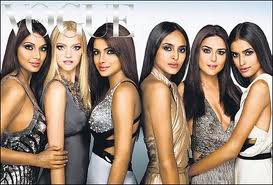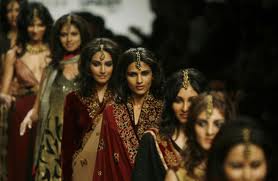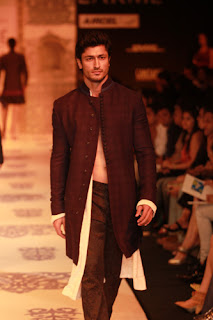In an industry so focused on appearance, perhaps we shouldn't be surprised that fashion advertisements and runways focus on a certain woman as the ideal displayer of their clothes - tall, statuesque, and, more often than not, pale. (Cough cough - Gisele Bundchen - cough cough.)
A couple days ago, The Fashionomist found an intriguing article (http://fashion.telegraph.co.uk/news-features/TMG8409583/Indias-models-accuse-fashion-industry-of-racism.html) regarding Indian models' accusations of the industry's inherent discriminatory bias against darker-skinned Indians getting premium jobs and pay. Indian society has long held paler skin to high regard - this is, after all, the country that has long held the virtue of fairness equating beauty.
(For proof, please refer to the infamous tube of "Fair & Lovely" [available at your local Indian grocer] and the bevy of Bollywood movie sirens whose paleness does not reflect the average Indian woman's "duskier" complexion.) Beautiful in their own way, the average Indian woman simply does not look like this.
A form of "skinism" is very much alive as a form of quiet discrimination occurring in many an Indian metropolis, where the hue of one's complexion is not only an apparent indicator of beauty, but, much like the racial discriminatory bias unfortunately experienced in American history, affects education, jobs, and income.
With the end of the premier Indian fashion exhibition, Lakme Fashion Week, came an outpouring of criticism from Indian models complaining of skin color bias. Many complained that homegrown productions were giving non-Indian models the best jobs because of their appearance. Who's cashing in? Blue-eyed, blonde/brunette beauties... who just happened to be pale. Yes, Eastern Europeans, Brazilians, and Russians, who admittedly look quite ravishing in ethnic Indian wear... but what's wrong with the run-of-the mill tan Indian woman?
It seems this shade discrimination has reached new heights in recent days after comments made by Indian model Dipannita Sharma, whose fiery tirade has ignited discussion among the Indian fashion elite:
"It's not just the fashion industry, India per se is obsessed with white skin. We will take another hundred years to completely get over it. The industry doesn't openly agree that preferring foreign models over Indian models just for the skin tone is racism. It has some kind of fairness obsession," she said. "One could have understood, if it was about getting supermodels of international fame or to work in India but that's not happening, it's just they want fairer skin on the Indian ramps," she added.




The fairness/racism issue in fashion is one that is close to The Fashionomist's heart. Beauty is neither the color of one's skin, the color of one's eyes, nor the color of one's hair. As idealistic as this sounds, true beauty lies in the way one carries oneself and their corresponding character. One might argue that in the business of fashion, art is war - the prettiest model fetching the most moolah is the most valuable. But racism has been reduced drastically in most fashion subsectors. Particularly in today's globalized economy, where it is in the fashion house's interest to promote their brand to an international clientele, using multicolored faces is good business.

Have you ever heard of the Hemline Index?
Originally coined by cheeky economist George Taylor, the Hemline Index refers to the (surprisingly proven) phenomenon that hemlines are excellent indicators of the economy's health: the shorter the hemline, the more booming an economy; the longer the hemline, the worse the economy.
History abounds with examples that seem to suggest that the Hemline Index is a decent indicator. Flappers had short skirts during the prosperous 1920s, only to be wearing longer draped hems during the Great Depression. The postwar era saw women being cautiously optimistic, with hemlines hitting the knee or being at shin-length (curiously, this exact length is this year's style). The happy-go-lucky 1960s hit, with the invention of many a parent's worst nightmare, the miniskirt. But then the more somber 1970s came along, with a little snafu called Vietnam coupled with unforeseen inflation and a gas crisis. And what were women wearing during this time? Prairie chic, boho skirts, of course! The early 1980s found skirt length creeping upwards, but the end of that infamous decade of fashion saw the return of the sidewalk sweeping skirt. The 1990s (those were sweet times, weren't they?) brought retro and barely-covering-the-bum skirts back, launching the millennium, which saw skirts hit the knee.







A brief post to quench the conciseness thirst of The Fashionomist's dear readers, who may find her ramblings a bit daunting...
Remember the 1980s? Probably not, as The Fashionomist's generation was still waddling around in diapers and trying to figure out why mommy insisted on mashed peas. But back then, our mommies were worrying about more than mashed peas and diaper spillage - inflation was at an all time high, up to 13%. Inflation isn't as bad now - rates are a measly 2.1% over the past year. However, take into account our frozen wages (compared to the 1980s, where wages were relatively keeping up with inflation) and, dear reader, you have a painful reality: there sure is some bang going on for every buck, and not the good kind.



(
http://www.benzinga.com/analyst-ratings/analyst-color/11/03/938763/goldman-sachs-comments-on-nikes-risks-following-earnings-)
reports that Nike may simply not have seen the price hike coming: the footwear giant set prices long ago (as many companies do) and did not figure climbing prices into its costs, putting Nike in danger of taking a "margin hit."
Nike isn't the only apparel company to announce increases in prices - Wrangler Jeans maker VF Corp and JC Penney's have announced similar increases in price. And increasing gas prices are not helping matters - retailers are highly concerned that shopping will fall if gas prices continue to creep upwards and consumers decide that the very tantalizing substitute option of shopping online (or perhaps saving precious moolah and not shopping at all) is preferable.
In any case, the Nike Index is not looking too promising in the coming months, at least not on this planet.
Source: http://www.chicagotribune.com/sns-ap-us-inflation-economy,0,1843250.story
*The Fashionomist*
As an Indian-American, The Fashionomist has always taken a keen interest in the evolution of the Indian fashion business, which has lagged behind that of the West but is quickly becoming one of the most rapidly growing fashion centers of the world. So when my friend Akshay sent me a link about India's fashion industry, I took note.




BBC gave a special report yesterday (http://www.bbc.co.uk/news/business-12802494) about the state of Indian fashion. On the heels of India's premier fashion extravaganza, Lakme Fashion Week (held in Mumbai last week), industry watchers are all wondering the same thing: Is India on the fashion map? If one pranced over to major news outlets that feature fashion, such as the New York Times, Wall Street Journal, and the like, the reader would have absolutely no idea that one of the world's emerging economies was putting on a week-long fashion show. Even Vogue India does not highlight it's country's hottest fashion week, setting up only a video link of highlights and a slideshow of photographs from shows. No discussion, no informative feedback, no analysis - what clearly separates this from Western productions of fashion week.
Indian fashion is taking on more importance, as the income effect is in place - with a rising middle class and more money comes a desire to spend on the luxuries of life. The Fashionomist would add another economic aspect of this trend - that of the newly independent woman in India. The Indian woman, traditionally homebound, is today a free bird who gets an education, works, and spends her money as she pleases. These trends, taken together, should be a boon for the Indian fashion business.




Boon it is... for domestic retailers. While nearly a quarter of fashion buyers of Lakme Fashion Week were foreign bred, Anil Chopra, the man behind Lakme's show, notes that sales to American and European brands are nearly non-existent, primarily becomes of the ornate, more conservative Indian aesthetic that predominates, making Indian fashion more viable to Middle Eastern clients who share the same couture sense. Westerners who may appreciate the exquisite workmanship integrated in Indian fashion are not keen to purchase sequin-drenched, beadified, heavily embroidered items of clothing that are simply not marketable to a Western audience. In fact, reports suggest "95% of business conducted as a result of fashion week is domestic."






For a country of 1 billion (and growing), that might not be bad business. But, The Fashionomist can't help but feel that the Indian fashion industry is restricting itself. Granted, Indian fashion is unique in its aesthetic and is heavily influenced by its complex history - ornamentation is king in Indian textiles, and classic draping via the sari, salwar kameez, or lehnga/choli combinations that predominate Indian womenswear are favored over the dresses and pants that dominate the Western runway. But a fusion and balance could be (and, in The Fashionomist's opinion, should be) achieved to broaden the Indian market's mass appeal and promote its beautiful handiwork to a wider audience. As Imran Amed, noted author of businessoffashion.com (a treasure trove of a website, may The Fashionomist add, for the business aspect of the fashion industry), Indian designers rarely try to reach for both the domestic and international audiences - something Western fashion designers do not have in their mind at all. This distinction in marketing has made certain designers seeking to break the mold "schizophrenic," in Amed's words, as the segregation between the two markets is rather monumental. Further fueling Indian fashion's hesitancy in going beyond its borders is the supply and demand issue - producing Indian garments is costly, both in time and money. Creating a line that is viable for the Western sense in terms of mass production and clean lines that are easier to manufacture is beyond the Indian art sense, thereby further reducing both supply and demand. Nevertheless, many observers think catering to the West is unnecessary, given the growing moneyed elite that increasingly pepper fashion shows and consume high Indian fashion.







The Fashionomist thinks that Indian fashion should take a hint from the West (who have dotted the Indian urban landscape with brands like Zara, Calvin Klein, Tommy Hilfiger, Dior... the list could go on) and globalization. While Indian fashion is unique in its aesthetic, promoting desi fashion (while retaining its inherent beauty and complexity) beyond the borders is very doable and very marketable, creating further demand for Indian fashion that would boost it to world renown. For a country known for donating the wonderful fashion staples of the Madras shirt, the jodhpur, and the Nehru jacket, India can easily become the next hot destination in international fashion circles if it melds in Western sensibilities.
See also: http://www.lakmefashionweek.co.in/
*The Fashionomist*




























































